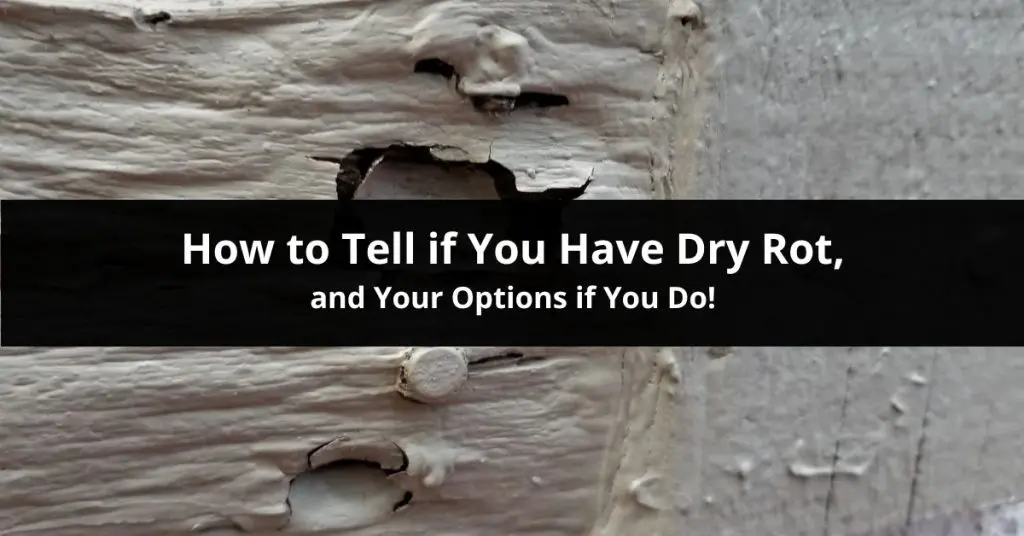If you have dry rot, you aren’t alone. Every year, around 20 billion feet of wood and boards are destroyed by dry rot in the United States alone. The good news is that catching dry rot early makes it easy to repair. And on the flipside, undiscovered dry rot can be expensive to fix, and in some cases make you need to sell your home.
In a worse case scenario, the dry rot in your wood will impact support beams, your walls, the roof and your floors and you end up with a condemned house. Buildings have even collapsed due to dry rot. But don’t worry, we’re here to help.
This guide to dry rot will teach you how to detect the severity of the issue in your home, and provide you with options based on your situation.
Click the following links to jump to a section if you would like the TL:DR version.
- What dry rot is and what to look for.
- Repairs and treatment options.
- What to expect if you need to sell a home with dry rot.
- Ways to prevent dry rot from happening.
What Dry Rot Is And How To Spot It
Dry rot is a wood fungus that makes the wood in your home brittle while causing it to lose up to 50% of its strength. Dry rot is a problem for homeowners and commercial properties because many have wood frames in the walls, and as part of the structure. There are two species of dry rot fungus, meruliporia incrassata (on the Pacific coast) and serpula lacrymans (on the East coast), and both eat away at building structures faster than any other mold.
You probably have dry rot if you see or smell:
- Patches of light purple, orange, or brown in your home that peel easily (known as spores)
- Grayish strands on wood (known as hyphae)
- Visible growth that looks like a fluffy white cobwebs (known as mycelium)
- Fruiting mushrooms with the spores
- Strained drywall
- Water droplets on wood surfaces
- Dark brown wood
- Brittle, weak, or soft wood
- A musty or damp smell
Dry rot is normally hidden within the inner structures of a home like beneath the floorboards, inside the crawl spaces, and behind walls. But it isn’t limited to hidden areas only. Dry rot can occur in visible places too like window and door framing, skylights, and even on counters or inside cupboards.
The areas to check for dry rot in your home include:
- Decks, porches, and patios
- Around windows (including skylights) and doors
- Floors that are by the tub, shower, and toilet
- Shower walls
- Around the home’s plumbing and pipes
- Exterior house trim
- Roof as well as gutters and flashing
- Wood siding
- Any wood around the foundation
- Cabinets underneath a sink
- Wood by sprinkler systems
Dry Rot Repair and Treatment
If you want to fight the “wood” fight, here’s the steps to treat dry rot:
- Find the cause of dry rot and fix it.
- Expose the full scope of the rot which can include taking down all of the drywall in a room.
- Remove the infected wood.
- Treat the area with a fungicide to stop the fungus in its tracks.
- Make sure it is safe for pets and kids if you have them within your home.
- Replace any wood that is brittle as it will no longer be reliable as structural elements.
The most important step in treating a dry rot problem is to get rid of the source of moisture as the moisture can bring the problem right back.
Removing the moisture can include repairing a damaged roof or wall, replacing leaky pipes, patching or replacing a leaky water heater that puddles up to wood, etc… Once the source of the water is gone the wood needs to dry. It is always a good idea to add additional ventilation as a way to reduce the humidity.
After these steps have been taken, it is time to treat the dry rot itself. Here are five common dry rot treatments.
- Borate-based preservatives destroy dry rot in existing wood. This method involves drilling holes in the affected wood and injecting a borate solution or spraying the solution over the infected wood. The downside to using borates is that they’re water-soluble which means the protective coating will wash away if there is an ongoing moisture problem.
- Glycol, a component in antifreeze, can be painted or sprayed on to the wood.
- Be careful, ethylene glycol can cause serious health problems with too much exposure. There are multiple types of Glycol, ask your hardware store which is best for your situation.
- Heat fumigation is a more natural way to treat dry rot as the heat removes the moisture and can help kill the fungus. The heat fumigation process starts when the room or house is covered in a tarp. Next the room or home is heated to dry out and kill the fungus.
- The microwave treatment is a new method, but only targets small areas. Like the name of the treatment, they essentially microwave the wood which kills the fungus. But this is an expensive and long process, and not readily available.
- Masonry surfaces can be treated by applying a high strength fungicidal microemulsion by spraying or injection.
If you have a mild case of dry rot (just a small area), you may be able to cut out the infected wood, spray a fungicide to the affected areas with a three-foot perimeter, and replace the wood you cut out. However, fungicide only works if the dry rot is in the first stages. This is the easiest solution, and likely the most cost effective.
According to Home Advisor, the cost to repair dry rot can be from $500 – $2,100 depending on the size of the area. However, the price increases substantially for structural damage and can range from $4,000-$12,000. If you have to replace items like an entire porch due to dry rot, the cost can go as high as $50,000! In addition to the cost, dry rot damage isn’t usually covered by homeowners insurance either. Most insurance companies have a clause that specifically excludes it, because they consider it preventable.
And dry rot needs to be disclosed if you’re selling your home. And if the dry rot is bad enough, you should not expect to get as many offers or top dollar.
Selling a Home With Dry Rot
If you don’t have the time or the money to treat dry rot, selling is your best option.
You can:
- Sell your home as is. However, some lenders will not give mortgages to homes with dry rot so you’ll need a cash buyer.
- List your home on the market and hope to find a buyer who will consider the cost of dry rot repairs and subtract them from the fair market price.
- Use a property auction to sell your home.
- Sell your home to a we buy houses for cash company like ours.
If selling your house is not on the table, or you’re lucky and don’t have dry rot, it is always a good idea to do quarterly or annual checks for prevention.
Ways to Prevent Dry Rot in Your Home
Here are the checks and ways to prevent dry rot in your home:
- Do a yearly check around your home for dry rot using the tips above.
- Seal the cracks around your exterior doors and windows with caulk.
- Clean your gutters at least twice a year (or more) to prevent blockages.
- Check your flashing to verify that water can’t get inside.
- Add a covered entryway over your doors.
- Use a dehumidifier in any room of the house with high humidity (especially basements).
- Install an exhaust fan in your bathroom to remove the steam from hot showers.
- Repaint your exterior windows and siding if the paint is cracking/peeling.
- Properly grade the yard around your home.
- Use decay-resistant or pressure-treated wood for exterior projects.
- Ensure that there is good drainage of water around your home.
- Regularly check for leaks underneath your vanities and cabinets and around toilets.
Dry rot can destroy a home from the inside out, but yours doesn’t have to fall victim if you catch and treat it early enough. If you suspect that you have dry rot, you now know what to do.


